Passive Cooling Solutions to Improve Thermal Comfort in Polish Dwellings
Abstract
1. Introduction
2. Methods
2.1. Research Object
2.2. Thermal Model
2.3. Ventilation Model
- Indoor air temperature varied in time steps based on EP;
- Airflow was through the windows and two ventilation ducts in each apartment (kitchen and bathroom) and omitted any airflow between the apartments and the staircase;
2.3.1. Closed Windows: One-Way Flow Using POWERLAW Model
- V—airflow, m3/h,
- n—exponent, n = 0.67 [36],
- ∆p—pressure difference, Pa,
- C—flow coefficient, m3/(h.Pan), defined as:
- a—airtightness factor, m3/(m·h·Pan), a = 0.3 m3/(m·h·Pa0.67) was adopted,
- l—the length of the window cracks, m.
2.3.2. Fully Open and Tilted Windows: Two-Way Flow Model (Single Opening)
2.3.3. Gravitational Chimney: Darcy–Colebrook Resistance Model
2.4. Controlling the Opening of Windows—Stochastic Model
2.4.1. Initial Restrictions
2.4.2. Restrictions in Window Control Regarding the Degree of Window Opening
- Tilt the balcony window (the highest window in the apartment),
- Tilt all windows,
- Fully open the balcony window and tilt the rest of the windows.
2.4.3. Restrictions in Window Control Regarding Time
2.4.4. Restrictions in Window Control Regarding Opening Degree
- To degree (1), if the wind speed was lower than X02 and the temperature difference between indoors and outdoors was smaller than X03;
- To degree (2), if the wind speed was within the range (X02, X04);
- To degree (3) in other cases.
2.4.5. Additional Restrictions
- The window opening degree decreased from 3 → 2 if the ambient temperature was lower than X10, or the ACH exceeded X11;
- The degree of window opening was reduced by one degree if the ambient temperature was lower than X12 and if the difference between the comfort temperature and the operative temperature was less than X13.
2.4.6. Optimization
- Hdis—number of discomfort hours,
- H(ACH > 5)—number of hours with ACH > 5 h−1,
- p—penalty factor (assumption, p = 10).
2.5. Climate
2.6. Case Studies
- Natural ventilation plus window opening (base case).
- Mechanical supply and exhaust ventilation with heat recovery. The system provided a constant fresh airflow throughout the year (CAV, Constant Air Volume, 126 m3/h for each apartment). A 70% heat recovery efficiency was assumed. The airflow value was entered directly into EnergyPlus. The ventilation airflow was chosen in accordance with the EN-16798-1: 2019-06 standard [32]: 10 dm3/s for the bathroom and 25 dm3/s for the kitchen (the two main rooms in the apartment).
- Mechanical supply ventilation (VAV). The system provided a variable fresh airflow throughout the year (VAV, Variable Air Volume). The fans were modeled in CONTAM and intended for additional cooling of rooms with cooler outside air in the summer. The fans started automatically when the room temperature exceeded 24.5 °C and the ambient temperature was lower than the indoor temperature and stopped at 23 °C. Two stages of operation were modeled: 1st stage—1.5× the standard airflow (189 m3/h)—if the difference between the indoor and outdoor temperature was higher than 20 K; 2nd stage—3× standard airflow (378 m3/h)—in other cases.
3. Results
3.1. The Effect of Additional Ventilation by Opening Windows and the Use of Internal Shades on Windows
3.2. Opening Windows vs. Mechanical Ventilation
4. Conclusions
- Demonstrated available solutions to reduce the negative impact of a warming climate on indoor conditions;
- Allowed the assessment of the potential of outdoor air cooling under conditions of variable external and internal heat loads;
- Compared the effect of people opening windows with automatically controlled systems.
Future Research
Author Contributions
Funding
Data Availability Statement
Acknowledgments
Conflicts of Interest
References
- Statistics Poland. Energy Consumption in Households. 2018. Available online: https://stat.gov.pl/obszary-tematyczne/srodowisko-energia/energia/zuzycie-energii-w-gospodarstwach-domowych-w-2018-roku,2,4.html (accessed on 15 May 2021). (In Polish)
- National Energy Conservation Agency. A Handbook of Typology of Residential Buildings with Examples of Measures to Reduce Their Energy Consumption; NAPE: Warszawa, Poland, 2011; Available online: https://episcope.eu/fileadmin/tabula/public/docs/brochure/PL_TABULA_TypologyBrochure_NAPE.pdf (accessed on 15 May 2021). (In Polish)
- Hamilton, G.; Shipworth, I.D.; Summerfield, J.; Steadman, A.P.; Oreszczyn, T.; Lowe, R. Uptake of energy efficiency interventions in English dwellings. Build. Res. Inf. 2014, 42, 255–275. [Google Scholar] [CrossRef]
- Porritt, S.; Cropper, P.; Shao, L.; Goodier, C. Ranking of interventions to reduce dwelling overheating during heat waves. Energy Build. 2012, 5, 16–27. [Google Scholar] [CrossRef]
- Badescu, V.; Laaser, N.; Crutescu, R. Warm season cooling requirements for passive buildings in Southeastern Europe (Romania). Energy 2010, 35, 3284–3300. [Google Scholar] [CrossRef]
- Shrubsole, C.; Macmillan, A.; Davies, M.; May, N. 100 unintended consequences of policies to improve the energy efficiency of the UK housing stock. Indoor Built Environ. 2014, 23, 340–352. [Google Scholar] [CrossRef]
- Schünemann, C.; Olfert, A.; Schiela, D.; Gruhle, K.; Ortlepp, R. Mitigation and adaptation in multifamily housing: Overheating and climate justice. Build. Cities 2020, 1, 36–55. [Google Scholar] [CrossRef]
- Sharifi, S.; Saman, W.; Alemu, A. Identification of overheating in the top-floor of energy-efficient multi-level dwellings. Energy Build. 2019, 204, 109452. [Google Scholar] [CrossRef]
- Nebia, B.; Aoul, K.T. Overheating and daylighting; Assessment tool in early design of London’s high-rise residential buildings. Sustainability 2017, 9, 1544. [Google Scholar] [CrossRef]
- Ascione, F.; Böttcher, O.; Kaltenbrunner, R.; Vanoli, G.P. Methodology of the cost-optimality for improving the indoor thermal environment during the warm season. Presentation of the method and application to a new multi-storey building in Berlin. Appl. Energy 2015, 185, 1529–1541. [Google Scholar] [CrossRef]
- Touchie, M.F.; Tzekova, E.S.; Siegel, J.A.; Purcell, B.; Morier, J. Evaluating Summertime Overheating in Multi-Unit Residential Buildings Using Surveys and In-Suite Monitoring. In Proceedings of the Thermal Performance of the Exterior Envelopes of Whole Buildings, XIII International Conference, Clearwater, FL, USA, 4–6 December 2016; Available online: https://taf.ca/wp-content/uploads/2018/02/ASHRAE_TAF_Paper_MURB_Summer_Overheating_2016-10-31.pdf (accessed on 15 May 2021).
- Gamero-Salinas, J.C.; Monge-Barrio, A.; Sánchez-Ostiz, A. Overheating risk assessment of different dwellings during the hottest season of a warm tropical climate. Build. Environ. 2020, 171, 106664. [Google Scholar] [CrossRef]
- Hamdy, M.; Carlucci, S.; Hoes, P.-J.; Hensen, J.L.M. The impact of climate change on the overheating risk in dwellings—A Dutch case study. Build. Environ. 2017, 122, 307–323. [Google Scholar] [CrossRef]
- Willand, N.; Ridley, I.; Pears, A. Relationship of thermal performance rating, summer indoor temperatures and cooling energy use in 107 homes in Melbourne, Australia. Energy Build. 2016, 113, 159–168. [Google Scholar] [CrossRef]
- Birchmore, R.; Davies, K.; Etherington, P.; Tait, R.; Pavic, A. Overheating in Auckland homes: Testing and interventions in full-scale and simulated houses. Build. Res. Inform. 2016, 45, 157–175. [Google Scholar] [CrossRef]
- Barbosa, R.; Vicente, R.; Santos, R. Climate change and thermal comfort in Southern Europe housing: A case study from Lisbon. Build. Environ. 2015, 92, 11. [Google Scholar] [CrossRef]
- Dodoo, A.; Gustavsson, L. Energy use and overheating risk of Swedish multi-storey residential buildings under different climate scenarios. Energy 2016, 97, 534–548. [Google Scholar] [CrossRef]
- Pathan, A.; Mavrogianni, A.; Summerfield, A.; Oreszczyn, T.; Davies, M. Monitoring summer indoor overheating in the London housing stock. Energy Build. 2017, 141, 361–378. [Google Scholar] [CrossRef]
- Elsharkawy, H.; Zahiri, S. The significance of occupancy profiles in determining post retrofit indoor thermal comfort, overheating risk and building energy performance. Build. Environ. 2020, 172, 106676. [Google Scholar] [CrossRef]
- Guo, H.; Huang, L.; Song, W.; Wang, X.; Wang, H.; Zhao, X. Evaluation of the summer overheating phenomenon in reinforced concrete and cross laminated timber residential buildings in the cold and severe cold regions of China. Energies 2020, 13, 6305. [Google Scholar] [CrossRef]
- Escandón, R.; Suárez, R.; Sendra, J.J.; Ascione, F.; Bianco, N.; Mauro, G.M. Predicting the Impact of Climate Change on Thermal Comfort in A Building Category: The Case of Linear-type Social Housing Stock in Southern Spain. Energies 2019, 12, 2238. [Google Scholar] [CrossRef]
- Homod, R.Z.; Almusaed, A.; Almssad, A.; Jaafar, M.K.; Goodarzi, M.; Saharif, K.S.M. Effect of different building envelope materials on thermal comfort and air-conditioning energy savings: A case study in Basra city, Iraq. J. Energy Storage 2021, 34, 101975. [Google Scholar] [CrossRef]
- Artmann, N.; Manz, H.; Heiselberg, P. Climatic potential for passive cooling of buildings by night-time ventilation in Europe. Appl. Energy 2007, 84, 187–201. [Google Scholar] [CrossRef]
- Oropeza-Perez, I.; Østergaard, P.A. Potential of natural ventilation in temperate countries—a case study of Denmark. Appl. Energy 2014, 114, 520–530. [Google Scholar] [CrossRef]
- Nicol, J.F.; Humphreys, M. Adaptive Thermal Comfort: Principle and Practice; Earthscan: London, UK, 2012. [Google Scholar]
- Rijal, H.B.; Humphreys, M.A.; Nicol, J.F. Development of a window opening algorithm based on adaptive thermal comfort to predict occupant behavior in Japanese dwellings. Jpn. Archit. Rev. 2018, 1, 310–321. [Google Scholar] [CrossRef]
- Building Research Institute. Large-Panel Construction—Report on Technical Condition; ITB: Warszawa, Poland, 2018. Available online: https://budowlaneabc.gov.pl/budownictwo-wielkoplytowe-raport-o-stanie-technicznym (accessed on 15 May 2021). (In Polish)
- Engineering Reference, EnergyPlus™ Version 8.7 Documentation; US Department of Energy: Washington, DC, USA, 2016. Available online: https://energyplus.net/sites/all/modules/custom/nrel_custom/pdfs/pdfs_v8.7.0/EngineeringReference.pdf (accessed on 15 May 2021).
- Dols, W.S.; Polidoro, B.J. CONTAM User Guide and Program Documentation; Version 3.4; National Institute of Standards and Technology: Gaithersburg, MD, USA, 2020; Available online: https://nvlpubs.nist.gov/nistpubs/TechnicalNotes/NIST.TN.1887r1.pdf (accessed on 15 May 2021).
- Walton, G.N. AIRNET—A Computer Program for Building Airflow Network Modeling; NISTIR 89-4072; National Institute of Standards and Technology: Gaithersburg, MD, USA, 1989. [Google Scholar]
- Blochwitz, T.; Otter, M.; Arnold, M.; Bausch, C.; Clauß, C.; Elmqvist, H.; Junghanns, A.; Mauss, J.; Monteiro, M.; Neidhold, T.; et al. The Functional Mockup Inter-face for Tool independent Exchange of Simulation Models. In Proceedings of the 8th International Modelica Conference, Dresden, Germany, 20–22 March 2011. [Google Scholar]
- EU Standard EN16798-1:2019. Energy Performance of Buildings—Ventilation for Buildings—Part 1: Indoor Environmental Input Parameters for Design and Assessment of Energy Performance of Buildings Addressing Indoor Air Quality, Thermal Environment, Lighting and Acoustics—Module M1-6; European Committee for Standardization: Brussels, Belgium, 2019. [Google Scholar]
- American Society of Heating, Refrigerating and Air Conditioning Engineers. ANSI/ASHRAE Standard 55-2017, Thermal Environmental Conditions for Human Occupancy; American Society of Heating, Refrigerating and Air Conditioning Engineers: Atlanta, GA, USA, 2017. [Google Scholar]
- Blaszczok, M.; Baranowski, A. Thermal improvement in residential buildings in view of the indoor air quality—case study for Polish dwelling. Archit. Civ. Eng. Environ. 2018, 11, 121–130. [Google Scholar] [CrossRef]
- Ferdyn-Grygierek, J.; Baranowski, A.; Blaszczok, M.; Kaczmarczyk, J. Thermal diagnostics of natural ventilation in buildings: An integrated approach. Energies 2019, 12, 4556. [Google Scholar] [CrossRef]
- Awbi, H.B. Ventilation of Buildings; Spon Press: London, UK; Taylor & Francis Group: New York, NY, USA, 2003. [Google Scholar]
- Pinto, M.; Viegas, J.; Freitas, V. Summer cross ventilation in residential buildings. In Proceedings of the Energy for Sustainability International Conference 2017 Designing Cities & Communities for the Future, Funchal, Portugal, 8–10 February 2017. [Google Scholar]
- Haldi, F.; Robinson, D. A comprehensive stochastic model of window usage: Theory and validation. In Proceedings of the Eleventh International IBPSA Conference, Glasgow, Scotland, 27–30 July 2009. [Google Scholar]
- Dutton, S.; Zhang, H.; Zhai, Y.; Arens, E.; Bennani Smires, Y.; Brunswick, S.; Konis, K.; Haves, P. Application of a stochastic window use model in EnergyPlus. In Proceedings of the SimBuild 2012, 5th National Conference of IBPSA, Madison, WI, USA, 1–3 August 2012. [Google Scholar]
- D’Oca, S.; Fabi, V.; Corgnati, S.P.; Andersen, R.K. Effect of thermostat and window opening occupant behavior models on energy use in homes. Build. Simul. 2014, 7, 683–694. [Google Scholar] [CrossRef]
- Fabi, V.; Anderson, R.K.; Corgnati, S.P.; Vanezia, F. Influence of user behaviour on indoor environmental quality and heating energy consumptions in Danish dwellings. In Proceedings of the 2nd International Conference on Building Energy and Environment (COBEE), Boulder, CO, USA, 1–4 August 2012. [Google Scholar]
- Borgeson, S.; Brager, G. Occupant Control of Windows: Accounting for Human Behavior in Building Simulation; Center for the Built Environment; University of California: Berkeley, CA, USA, 2008; Available online: https://escholarship.org/uc/item/5gx2n1zz#main (accessed on 15 May 2021).
- EnergyPlus Weather File. Available online: https://energyplus.net/weather (accessed on 15 May 2021).
- University of Southampton. Climate Change World Weather File Generator for World-Wide Weather Data–CCWorldWeatherGen. Available online: http://www.energy.soton.ac.uk/ccworldweathergen/ (accessed on 15 May 2021).
- Verichev, K.; Zamorano, M.; Carpio, M. Effects of climate change on variations in climatic zones and heating energy consumption of residential buildings in the southern Chile. Energy Build. 2020, 215, 109874. [Google Scholar] [CrossRef]

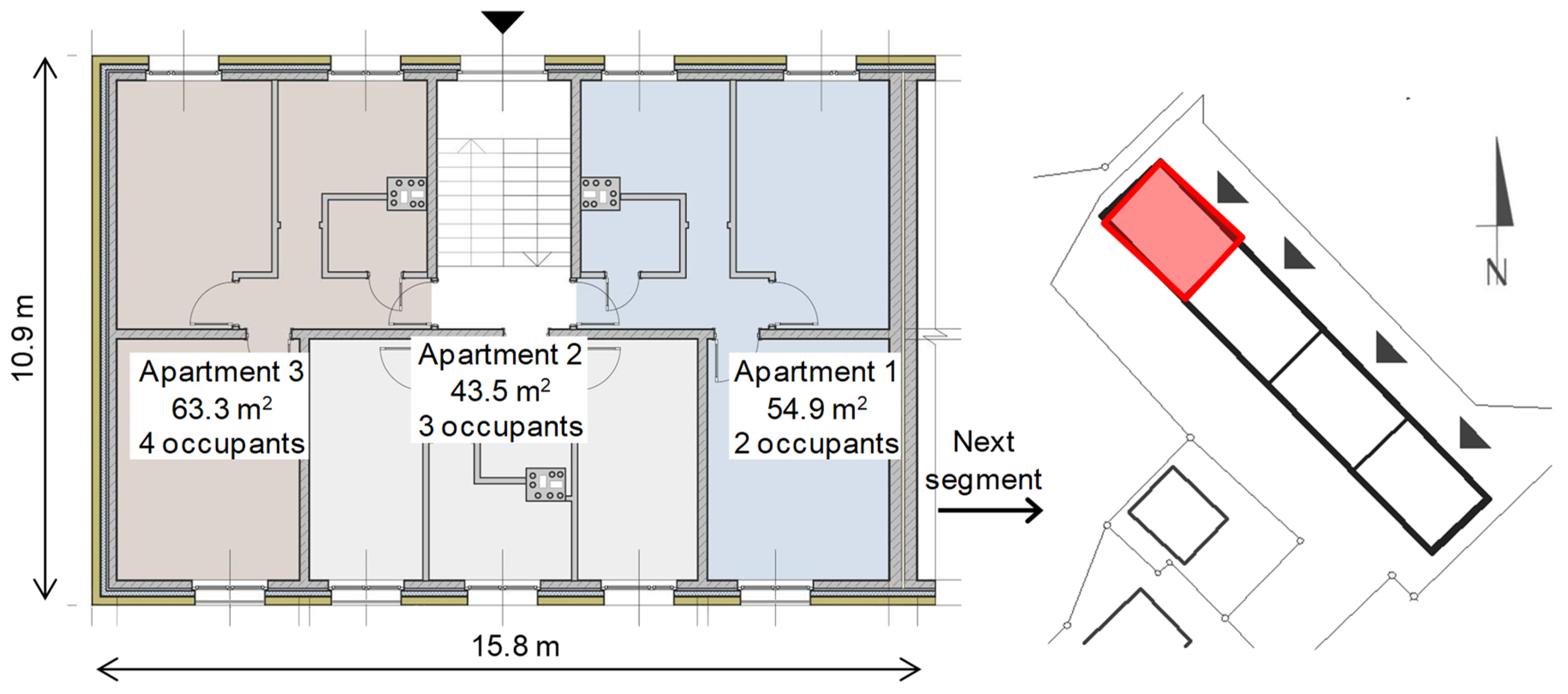

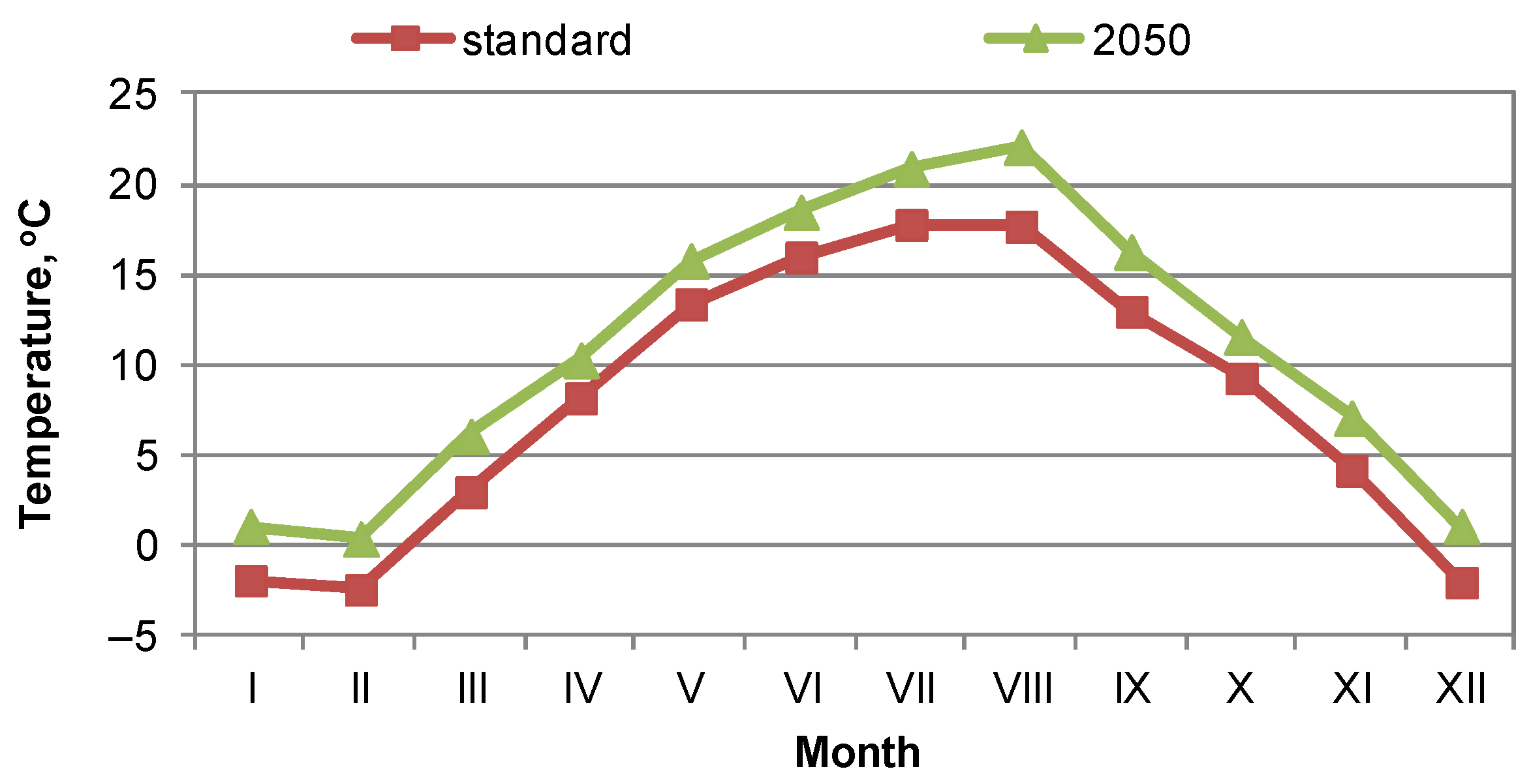

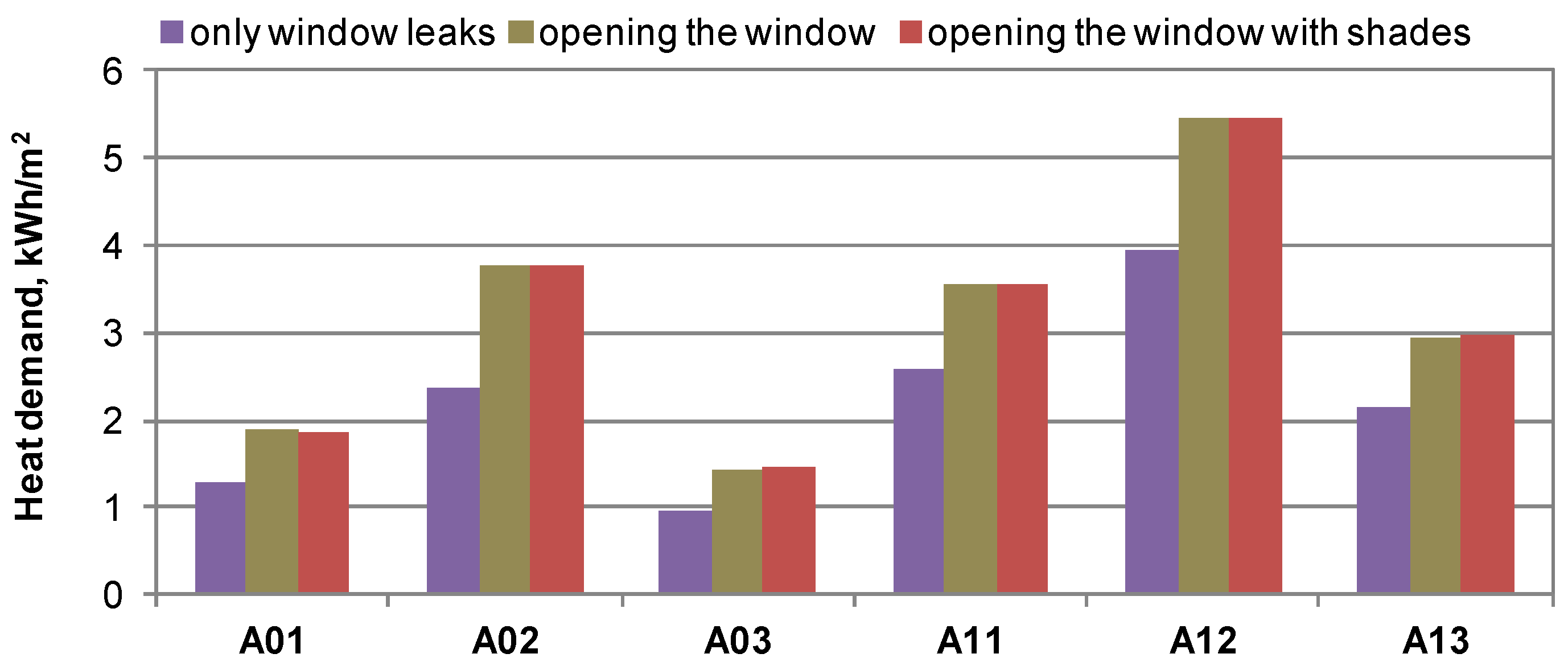

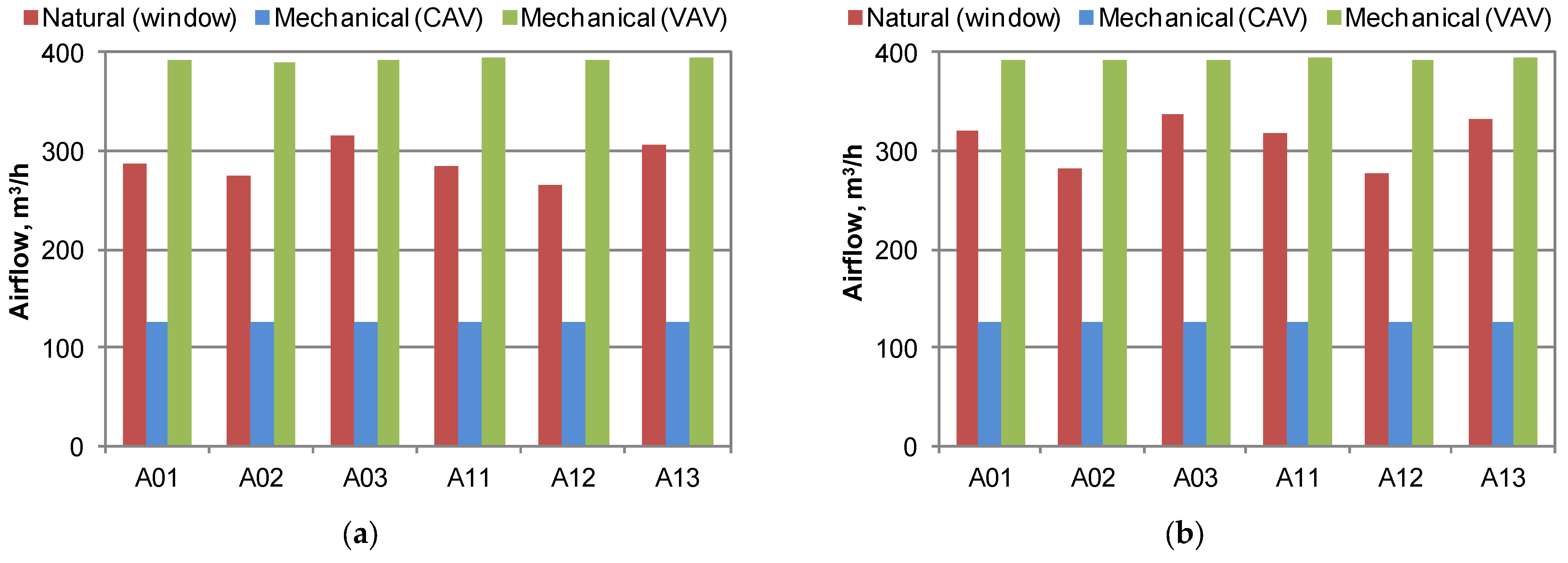
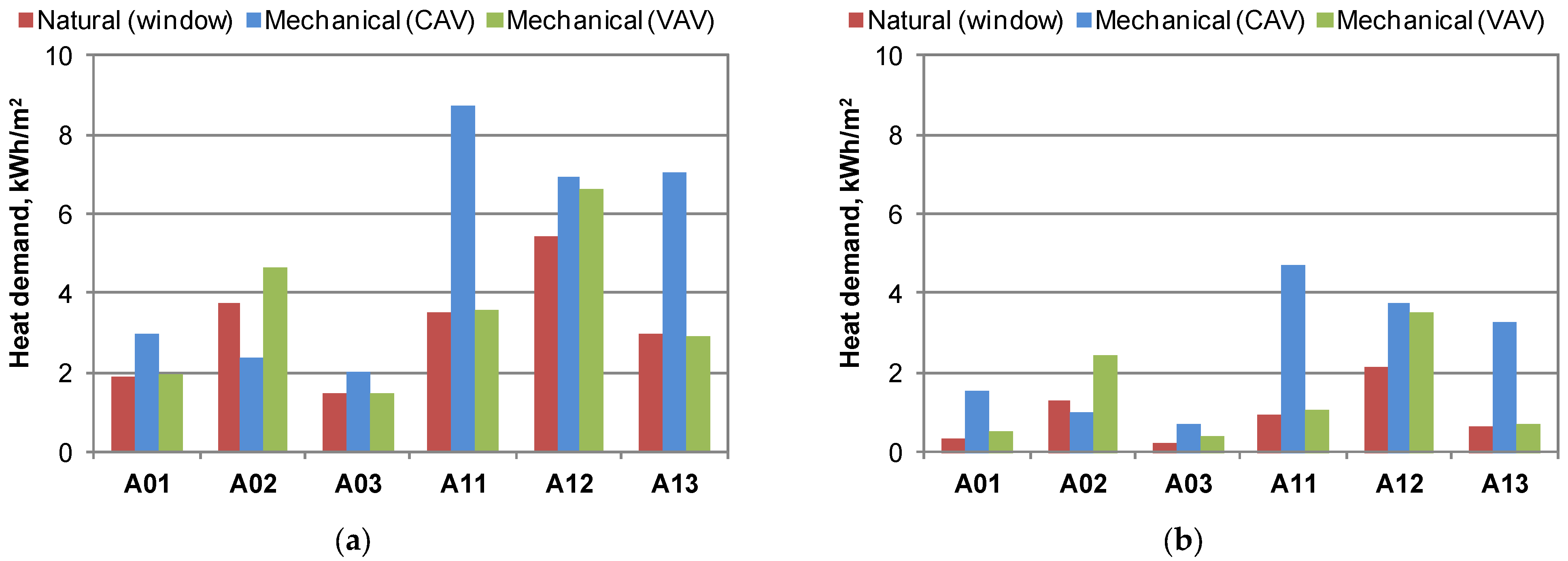
| Case | Standard Climate | Warm Climate | |||||||||||
|---|---|---|---|---|---|---|---|---|---|---|---|---|---|
| A01 | A02 | A03 | A11 | A12 | A13 | A01 | A02 | A03 | A11 | A12 | A13 | ||
| Natural (by window) | avg 1 | 88 | 251 | 195 | 113 | 280 | 219 | 860 | 1145 | 1050 | 893 | 1181 | 1079 |
| max 2 | 112 | 274 | 230 | 140 | 305 | 258 | 903 | 1166 | 1086 | 950 | 1221 | 1110 | |
| min 3 | 78 | 222 | 165 | 79 | 267 | 192 | 825 | 1123 | 1006 | 862 | 1159 | 1027 | |
| Mechanical (VAV) | 4 | 45 | 28 | 10 | 39 | 34 | 369 | 504 | 604 | 436 | 545 | 640 | |
| Mechanical (CAV) | 3034 | 3156 | 3170 | 2973 | 3070 | 3076 | 3602 | 3672 | 3646 | 3551 | 3605 | 3631 | |
Publisher’s Note: MDPI stays neutral with regard to jurisdictional claims in published maps and institutional affiliations. |
© 2021 by the authors. Licensee MDPI, Basel, Switzerland. This article is an open access article distributed under the terms and conditions of the Creative Commons Attribution (CC BY) license (https://creativecommons.org/licenses/by/4.0/).
Share and Cite
Ferdyn-Grygierek, J.; Grygierek, K.; Gumińska, A.; Krawiec, P.; Oćwieja, A.; Poloczek, R.; Szkarłat, J.; Zawartka, A.; Zobczyńska, D.; Żukowska-Tejsen, D. Passive Cooling Solutions to Improve Thermal Comfort in Polish Dwellings. Energies 2021, 14, 3648. https://doi.org/10.3390/en14123648
Ferdyn-Grygierek J, Grygierek K, Gumińska A, Krawiec P, Oćwieja A, Poloczek R, Szkarłat J, Zawartka A, Zobczyńska D, Żukowska-Tejsen D. Passive Cooling Solutions to Improve Thermal Comfort in Polish Dwellings. Energies. 2021; 14(12):3648. https://doi.org/10.3390/en14123648
Chicago/Turabian StyleFerdyn-Grygierek, Joanna, Krzysztof Grygierek, Anna Gumińska, Piotr Krawiec, Adrianna Oćwieja, Robert Poloczek, Julia Szkarłat, Aleksandra Zawartka, Daria Zobczyńska, and Daria Żukowska-Tejsen. 2021. "Passive Cooling Solutions to Improve Thermal Comfort in Polish Dwellings" Energies 14, no. 12: 3648. https://doi.org/10.3390/en14123648
APA StyleFerdyn-Grygierek, J., Grygierek, K., Gumińska, A., Krawiec, P., Oćwieja, A., Poloczek, R., Szkarłat, J., Zawartka, A., Zobczyńska, D., & Żukowska-Tejsen, D. (2021). Passive Cooling Solutions to Improve Thermal Comfort in Polish Dwellings. Energies, 14(12), 3648. https://doi.org/10.3390/en14123648








